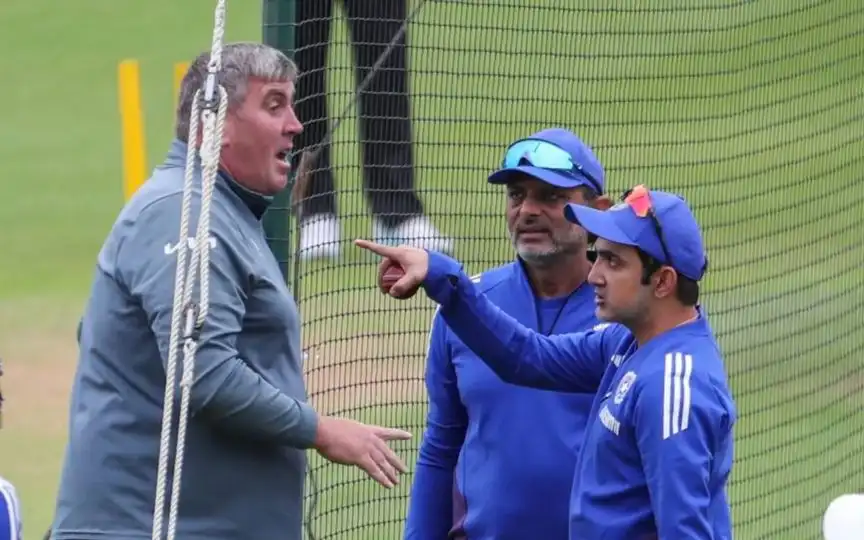.jpg?type=hq) Gambhir, Gill and Kuldeep Yadav in Indian camp (Source:@Jay_Cricket12/X.com)
Gambhir, Gill and Kuldeep Yadav in Indian camp (Source:@Jay_Cricket12/X.com)
What do you expect when two top-cricketing nations go up against each other in a long and laborious five-match Test series - quality cricket, close contest, some fierce and passionate altercations; The Anderson-Tendulkar Trophy 2025 will be remembered for all of that.
Gill-Gambhir Assemble A Fighting Brigade Of Underdogs
It started off as a battle between a high-flying Bazball-inspired England and a young and inexperienced Indian team under a new captain looking to find its feet. Not many gave India a chance before the series started, and some even expected England to whitewash the visitors once they chased down the target of 371 at Headingley.
However, the young Indian brigade under Shubman Gill and Gambhir stood tall against all odds and right from the first encounter, which they lost, the fight has been evident. At the start of the series, the pressure was on batters to deliver after the retirement of Rohit and Kohli, but not even once did it feel like India were missing their superstars.
As the series progressed, Bumrah's fitness conundrum took centre stage with various other injuries in the camp, but the fight continued, and Gill and co. are now close to levelling the series, a feat very few Indian teams have been able to achieve in UK. Even if they lose, and the scoreline shows 3-1, the people who have watched the action closely will remember it as one of the most closely fought series in Test cricket history.
The Loud Voice For Wicket-Taker, Kuldeep Yadav
Right throughout the series, there were plenty of battles on and off the field and all five games went right till the final session, which speaks a lot about the punches and counter-punches from both sides. So, a young Indian team, which has just started its transition, deserves a lot of praise for not only fighting it out on the field, but also for backing their tactics, which came under a lot of criticism.
One of those hot topics of discussion was the non-selection of Kuldeep Yadav. From Sourav Ganguly, Kevin Pietersen, to even social media cricket pundits, everyone urged the Indian team management to play Kuldeep Yadav. But Gill and Gambhir were in the mood for a rebellion; there were numerous temptations and pressure on the way, but though India chopped and changed, Kuldeep was not given a chance in India's playing XI.
There is no doubt that Kuldeep Yadav is a genuine wicket-taker, a bowler who has the ability to take the pitch out of the equation. Thus, his selection on the flat decks that were dished out for the majority of the series could have strengthened India's bowling attack, but would it have given India the best possible balance in English conditions? Let's find out.
India's Search For Balance Against Popular Opinion
In the first Test, India went with three frontline pacers, along with a spinner, Jadeja and seam-bowling all-rounder Shardul Thakur. It was the first game of the series, and historically, teams have not played two spinners in English conditions. Thus, India went with a tried and tested combination, and the inclusion of Shardul Thakur was because of his ability to contribute with the bat apart from his bowling.
In modern-day cricket, teams prefer to go with a cricketer at number 8 who can contribute with the bat as well. Kuldeep Yadav's inclusion would have limited India's batting line-up to just number seven, and given the Indian tail's history of vanishing quickly in overseas conditions, it was a risk that the management did not take.
After the loss in the first Test and India's inability to take 10 wickets, the call for Kuldeep Yadav's inclusion got louder. Bumrah was also not available, and thus, India's bowling attack looked weak on paper, at least to the majority of people outside the Indian dressing room.
Gautam Gambhir and his management, though, did not listen to the outside noise and at Edgbaston, India decided to drop an extra batter and bring players into the team who can provide an option with both bat and ball. Thus, Nitish Reddy and Washington Sundar came into the frame. The move was widely criticised at the start of the match, and many believed that Kuldeep, the more attacking bowler, should have been preferred over Washington Sundar.
Washington Sundar: A Defensive Option?
However, cricket is a team game, and sometimes to complete a perfect puzzle, you just need the right piece at the suitable position rather than the best or the most attractive of the lot. And that is what Gambhir and Gill did! Sundar may look like a defensive bowling option, but in the few Test matches he has played so far, the 25-year-old has done his job brilliantly. At Edgbaston, he walked out to bat when India were 414-6 in the first innings and there were chances of India being restricted to under 500, given the lower order's performance in the last match.
Washington's 144-run stand with Gill did not let that happen, and that big first innings score on a flat deck played a big role in India's win in that match. Sundar also grabbed Stokes' wicket in the final innings and performed a spinner's role in English conditions to perfection.
At Lord's, India went with Nitish and Washington Sundar again, and both of them made some important contributions with both bat and ball. Washington picked four wickets in the second innings of that Test, and India managed to pick 20 wickets again, contrary to the widespread narrative that the visitors need Kuldeep Yadav to do so.
In the drawn Manchester Test, Sundar again delivered with the bat, scoring a century while walking out to bat at number 5 to save the Test. He picked two wickets too, and now in the final Test, he has shown his utility again with a crucial fifty in the second innings to take India's lead to a position where England were only left with an option of creating history if they want to win the game and series.
Three Spinners, Is That Even A Option In English Conditions?
So, it is clear that Washington Sundar has justified his selection in almost all games he has played. At the other end is Ravindra Jadeja, another spin-bowling all-rounder who has been nothing short of brilliant and is almost undroppable. So, the question is, where was the possibility to include Kuldeep Yadav? Is it even practical to play three spinners in England? The pitches have not exactly been traditional green tops, but they are not a dust bowl either, where a team will benefit by playing three spinners.
One needs at least three pacers in a playing XI in England, and India have managed to field those, despite playing two spinners, and it has been possible only because they have selected spinners who can contribute with the bat as well. Thus, it is a straightforward case of Gambhir and Gill putting the balance of the team ahead of individual charisma despite the social media narratives and intense outside pressure.
Remember The Result, But Never Forget The Silent Inner Battles
The performance of the team is right in front of everyone. The historic win at Edgbaston, dominating the majority of sessions in a country like England - the young team in transition has done it all. As mentioned earlier, there were not many who even thought that India would compete in the series after losing to the Kiwis at home and in Australia.
The unexpected retirement of superstars added more fuel to the fire, but Gill and Gambhir, who have been expressive on many other occasions, decided to fight a silent, unpopular battle by ignoring a highly-rated spinner for the team's cause. They may still get criticised, and that is the nature of life, but these are the qualities that the leadership group needs to adopt for the larger picture. 20, 30 or 50 years down the line, people might just remember the result of the series, but there will be few who will remember how the team defied the popular opinion and kept fighting as a group against all odds.



.jpg?type=mq)



